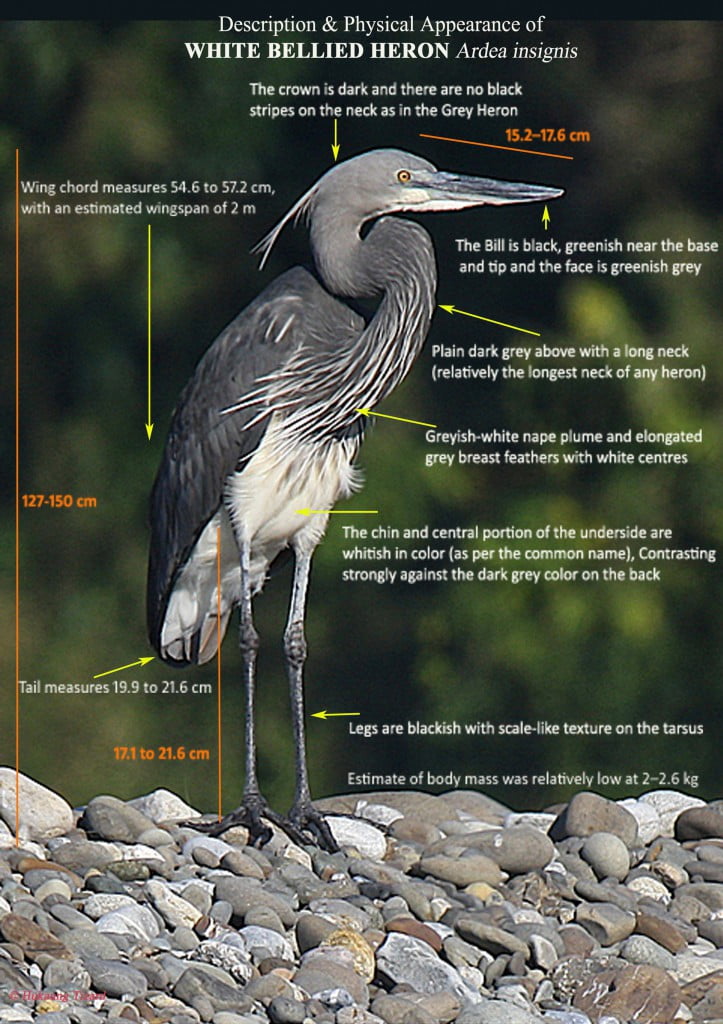Niraj Kakati and Nilmani Rabha
A relatively big bird suddenly took flight a few hundred meters ahead of us, though we had not noticed it on the ground. It was of robust size, with large wings, recoiled neck and greyish in colour. As the bird settled on the bank of a stream further apart, we peered through the binocular. Yes, there it was, standing still with its long neck raised and staring in our direction. We clicked photographs with maximum zoom and all of us crowded over the camera display screen. Confirmed…White-bellied Heron sighted; the first for our team!
It had been three hours since we left our base camp, the Forest Inspection Bungalow at Phibsu under Kachugaon Forest Division of Manas Tiger Reserve, Assam. It was cold and almost dark when we set out early in the morning at 05:30 A.M. on 22rd November, 2013. However, once the sun emerged from behind the tall Bombax and Lagerstroemia tree forest, the light spread rapidly. The River Phibsu, from which this area derives its name, flows down from Bhutan and is relatively wide at nearly 400 metres bank-to-bank, though largely dry and negotiable on foot during the winter months. It was characteristic ‘bhabar’ terrain where rivers carry enormous amount of silt and rock debris from the upstream areas aided by the heavy seasonal rainfall, fragile nature of the rock formation and steep channel gradient. We trekked along slowly, crisscrossing the shallow streams and sometimes moving along the rocky bed, flanked by mostly moist deciduous forest on either side of the river.Numerous birds greeted us on our morning sojourn including the lapwing, wagtail, kingfisher, little heron and serpent eagle among others.
Even as we were busy identifying the chirping birds, one of the guards accompanying us cried, “elephant! elephant!” To our shock, a solitary wild elephant (called ‘makhna’, i.e., a male without tusks) was standing in our path barely 50 metres away and we had literally walked into it. Three of our members including Heron Guardian, Rajual Islari, were too close to the elephant for comfort and instinctively turned around and ran. The elephant mock charged, but the three of us who were slightly behind, stood our ground. The pachyderm stopped, abruptly changed direction and disappeared into the forest. Well, the incident surely startled us,but we moved ahead with purpose and all our senses had awoken to full alertness. As is believed in this part of the world, elephants are a good omen!
It was about 8:30 A.M.when we reached the Indo-Bhutan border after traversing about 2.5 – 3 km from base camp. At the end of the stream survey, we held in the area for enumerating the birds by point count method. We spotted a black stork flying in the area which was a positive indication of available habitat for large fish-eating birds. Just as we had finished the point count and were observing the habitat on the Bhutan side, the large greyish bird flew up in the air and landed along a stream some 200 meters away. The river bed was about 40 meters wide at the site, though the stream width was only 10 meters. The white-bellied heron is known to prefer undisturbed and inaccessible areas, dwelling in forest streams and broad rivers, and feeding on fish. Its physical appearance is distinctive, standing at over 1 meter in height as the world’s second largest heron. It has a massive bill, relatively the longest neck of any heron and a whitish-coloured underside contrasting strongly against the dark grey colour on the back.
We made another foray to the same location around the same time the next day. And behold, we encountered the white-bellied heron again! This time it was further inside the Indian border. Amazingly, a second white-bellied heron appeared on the scene which indicated that a pair had been visiting the area. We spent an hour observing the bird and the bird kept a determined watch on us as well! Finally, it flew away towards the thickets in the Bhutan side.
The white-bellied heron is a Critically Endangered species with an estimated global population of less than 250 mature individuals and is listed among the fifty rarest birds in the world. It is threatened by habitat degradation and disturbance in the few areas where it is still known to exist. During our survey, we actually encountered two persons who were fishing in the streams with drag nets. They had trekked nearly 15 km from their village to that location for a basket-full of fish. Earlier, we had met a pair of cattle-herders near our base camp who not only seemed to recognize the white-bellied heron from the pamphlet we were carrying but also pointed us to the potential location of the bird which was quite proximate to the site of our actual sighting! While we contemplate the challenges for the species’ survival, our sighting of the bird also strengthened our motivation and determination to help secure the species and its habitat.
The survey was supported through an IUCN-SOS grant.Members of the team who reported the sighting belonged to NGOs ATREE, Green Forest Conservation and forest staff.
Ashoka Trust for Research in Ecology and the Environment (ATREE),
Guwahati, Assam.







